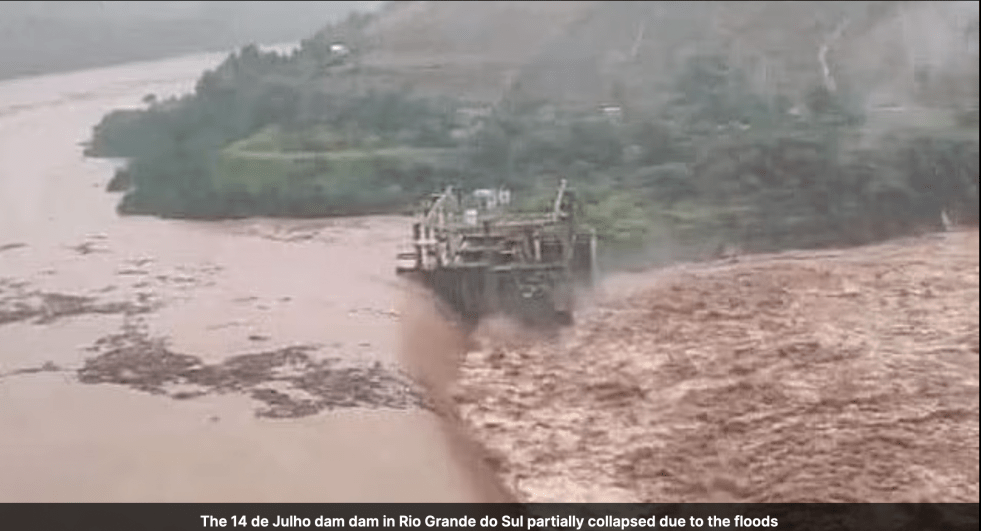A dam which was part of the 14 de Julho hydropower plant in Brazil has partially collapsed on May 2, 2024, following heavy rains that started on Apr 29 and expected to be continued to May 3[i]. The breached dam, located between Cotiporã municipality and Bento Gonçalves city, reportedly created a 2m wave, exacerbating the floods in the already inundated areas. Meteorologists attribute the extreme weather event to an unusual amalgamation of soaring temperatures, elevated humidity levels, and fierce winds.
The 100 MW project, also called Catorze de Julho, is located on the estuary of the Antas River. The roller-compacted-concrete (RCC) dam has a maximum height of 42 m. The underground powerhouse contains two Kaplan turbine-generator units. The first unit began commercial operation in January 2009. 14 de Julho is part of the 360 MW CERAN complex.[ii]
RCC, a method known for its affordability and speed, but which is now facing scrutiny for its vulnerability to extreme weather events. The tragedy underscores the urgent need for robust construction practices, particularly in the face of increasingly unpredictable weather patterns attributed to climate change.[iii]

The death toll jumped to 32, with another 62 people missing, according to the state’s civil defense agency.[iv] The burst dam created a 2 m high wave in the downstream, compounding the floods.[v] By May 5, the no of death had reached 78 and no of missing at 105. Over 3 lakh people are left without electricity.
Over 15,000 residents have evacuated their homes since May 4, with power and clean water infrastructure severely compromised. CERAN – Companhia Energética Rio das Antas issued a statement, saying that vigilance remains paramount, with the potential for escalated rainfall to exacerbate the situation.
Eddie Rich, CEO of the International Hydropower Association, commented: “As temperatures rise and weather patterns become increasingly unpredictable, investment in and maintenance of vital infrastructure will become more necessary.”
This is unfortunately the latest high-profile dam collapse, which are expected to become more frequent as climate change-induced floods mix with an aging fleet of dams. Last year, Libya experienced the world’s second deadliest dam disaster after a severe rainstorm collapsed two dams, killing thousands.[vi]
As the world faces increasingly severe weather events, the likelihood of such disasters only grows. We must prioritize approaches like moratorium on large dams, dam upgrades or removal, improved monitoring and restoration and protection of river floodplains to mitigate these risks and protect vulnerable communities worldwide. All this is equally applicable for India as India faces increased disaster vulnerability and large fleet of old, earthen and risky dams.
SANDRP (ht.sandrp@gmail.com)
[i] https://www.waterpowermagazine.com/news/newsdam-of-14-de-julho-power-plant-in-brazil-partially-collapses-fatalities-reported-11737530
[ii] https://www.hydroreview.com/dams-and-civil-structures/dam-safety/partial-dam-failure-reported-at-14-de-julho-hydroelectric-project-in-brazil/
[iii] https://www.concreteconnect.co.uk/news/dam-collapse-raises-concerns-over-rcc
[iv] https://www.youtube.com/watch?v=ldtgcYals2U
[v] https://www.youtube.com/watch?v=49rh4-nsrvU
[vi] https://www.internationalrivers.org/news/statement-on-the-dam-collapse-in-rio-grande-do-sul-brazil/
